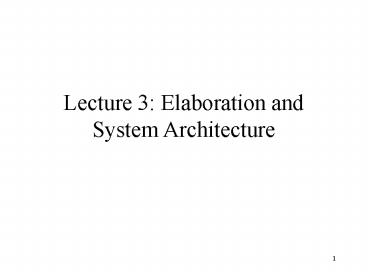Lecture 3: Elaboration and System Architecture - PowerPoint PPT Presentation
Title:
Lecture 3: Elaboration and System Architecture
Description:
Lecture 3: Elaboration and System Architecture – PowerPoint PPT presentation
Number of Views:135
Avg rating:3.0/5.0
Title: Lecture 3: Elaboration and System Architecture
1
Lecture 3 Elaboration and System Architecture
2
Why Now?
- System Architecture is often considered design,
not requirements/elaboration - Personal past experience
- Have a ready system metaphor we can use
- Industry past experience
- Study other experiences to get some insight
- Examine technology to see what it will support
3
System Architecture
- Basic Pieces of the system
- Components, Modules, Subsystems
- Structure of the System
- Relationships between pieces
- Solution Strategies for System
- Is this Architecture?
- E.g. Analysis and Design Mechanisms
4
Mechanisms
Analysis Design Implementation
Persistency Relational DBMS JDBC
Distribution Remote Method Invocation Java 2
5
Tiers
- Physical tiers
- Separate machines, e.g. client/server
- Logical tiers
- Logical components, e.g. GUI, Business Logic,
Data-Base - Refinements
- E.g.
- Thin client presentation logic only
- Fat client presentation logic plus business
logic
6
Layers
- From OS layers of progressively more abstract
machines, each of which uses the services of
lower levels - Logical Tiers and Layers
- GUI
- Business/Application/Domain Logic
- Data Base
7
Model-View Separation
- Layers model for GUI oriented application
- View-GUI
- Model
- View layer displays information known from model
layer - Why?
- Divide and conquer approach to development
- Can make changes to GUI without touching the
guts of the system
8
Model View Controller
- View graphics presentation
- Model Business Logic
- Controller respond to input from View by
calling on Model, updating view with information
from model - Java, VB, etc.- view classes have associated
event responders. Controller merged into View
9
MV Separation and Callbacks
- View can call on model to get information to
display - How does lower level Model alert View about
something that needs to be displayed? - View calls a model method with an identifier for
a method to be called when the condition of
interest happens. Passed method is called a call
back function
10
Observer/Observable -1
- Based on a design pattern
- Java Classes
- Can be used to support callbacks
- Observers register with observable
- Observable when instructed, will call the
observers update() method
11
Observer/Observable 1
- Observer is an interface
- Implementer class must implement
update(Observable obs, Object arg) - Observable is a class
- Includes
- addObserver(Observer obs)
- notifyObservers(Object arg)
12
UML and Components
- Components
- Pieces of the system architecture
- Layers, modules, logical tiers
- May be nested subcomponents
- UML packages
- Collections of classes and packages
- May be used for modeling components
13
Subsystems
- Package plus one or more interfaces that define
the services supported by the subsystem - Layers can be modeled as subsystems
- Interfaces set of method specifications, e.g.
Java interfaces
14
Subsystems and Proxies
- Proxy stands in for something, takes its place,
simulates or interfaces with some entity - Subsystem interface can be a proxy which may
either simulate a subsystem, or call methods in
an implemented subsystem - Proxy is another example of a pattern
15
Java Subsystems
- Possible units of organization
- Files
- Folders
- Classes
- Packages
16
Files and Subsystems
- Files units of compilation
- Compilation produces class files for each class
in a file - Too small a unit for organizing subsystems
- Class in one file has limited visibility (i.e
ability to create an instance of) to classes in
other files.
17
Inner Classes and Subsystems
- Inner Class
- Defined inside another class
- Has access to variables of enclosing class
- Subsystems consist of a principal class (e.g.
subsystem proxy controller), and its inner
classes? - Problems e.g.
- Cannot have static members in inner classes
- Cannot access inner classes from the outside
18
Folders and Subsystems
- Associate subsystems with folders
- When class file is compiled, compiled class files
will go into the same folder - Use different class path designators so that
compiler and java run time can find referenced
class files
19
Packages
- Java Package is a collection of classes
- Package is associated with a folder
- Can use import statement in a file to identify
source of classes used in file - Use package statement to identify a file as
belonging to a package - Use import to identify sources of referenced
classes
20
Packages and Subsystems
- Subsystem is a package
- Package has interface classes for the subsystem
- Visibility
- Normal can see the public class in another file
- Package can see non-private (public and
friendly undesignated) entities in other files
21
Note on security and package visibility
- Suppose you have a system library class Window
in java.awt that contains a friendly (not
public or private) variable - String warningString.
- Create a file, for example, called SetWarning
with a SetWarning class, and include package
java.awt in the file. - Put the class in a subdirectory java/awt
somewhere on the class path and you can use it to
alter this variable - Security manager will stop you if you try this in
an applet (i.e. try adding to system packages)
that is loaded from the Internet
22
Additional Packages
- Globals
- E.g. MemberData in DS
- Utility routines
- E.g. Classes used for tracing and debugging
- Subsystem interface definitions?
23
Dating System Architecture
24
Start Up Logic
25
Distributed Systems Architecture
- Stand Alone versus Client Server
- Basic Model Communicating State Machines
- Components client(s) and server
- Component specification state machine
26
Client Server Model































